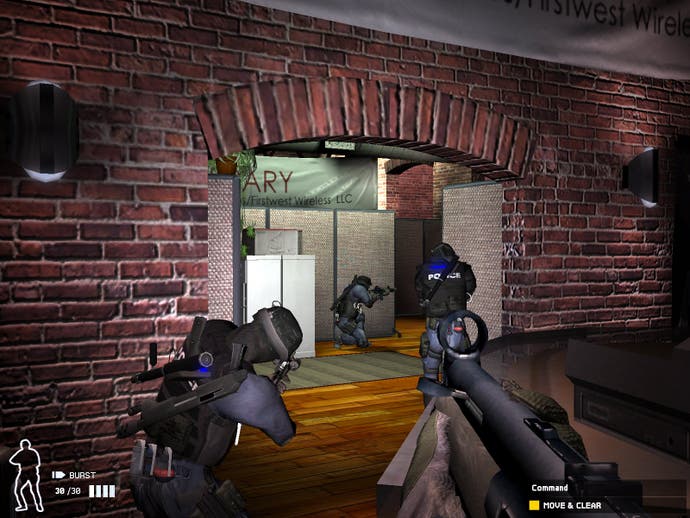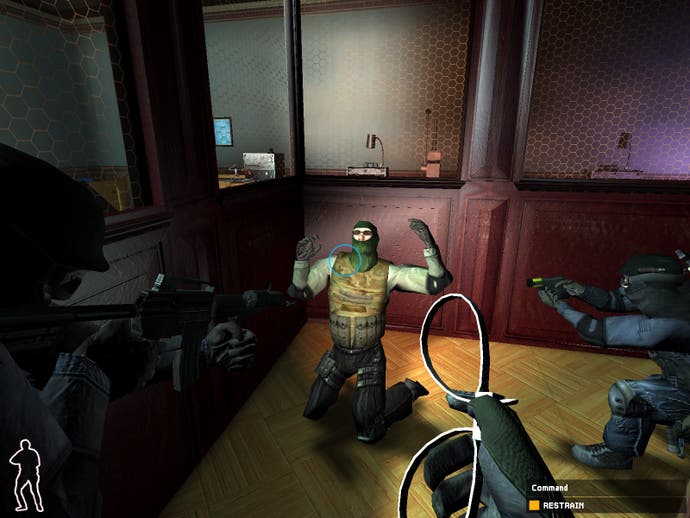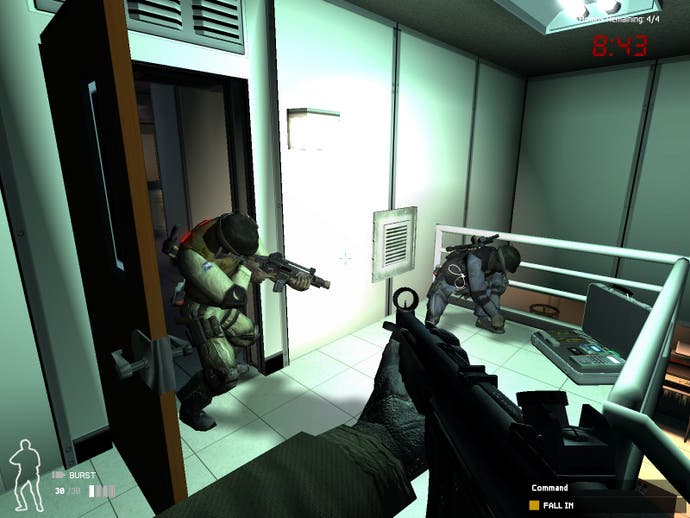SWAT 4 Review
To get to the head of the tactical shooter class, you have to swat.
I just want to slam my fist into this whining hostage's face. Is it too much to ask?
Clearly watching the first two series of top ultra-corrupt cop show The Shield in a couple of weeks have left dirty marks on my consciousness, but I haven't quite gone native into the world of missing Mitchell brother Vic Mackey yet. I'm not asking for the full strike team experience of holding a man's face against an electric oven or urinating over suspects in the street or anything. I just want fist in face. Right now.
He's just not co-operating. I need to handcuff the wretch to secure him for extraction, and unless he gets on his knees, I can't do that. I know I can pull out my handy aerosol of MACE to forcibly hitch him to my train of thinking, but why hurt Mother Nature by releasing more nasty chemicals into her lungs when she gave me five fingers thick enough for the job?
Alas, no, face-punching in SWAT 4. It isn't that sort of police game. It's very much good cop, and its failings in this area are more my failings in being bad cop. It sticks to the rulebook of engagement clinically, which leads it to being one of the more unique tactical-action games available to the modern MP5-toting gamer.
Perhaps uniquely in the recent iteration of the second-string game franchises, it doesn't fiddle with the formula to any huge extent in an attempt to reach a different (i.e. bigger) audience. While individual mechanics have altered (though there's the option to swap to a control system more akin it its veteran cop forefather for purists and/or retrophiles) and everything has been spruced up to 2005 standards, it's still recognisably the same game. That is, a recognisably brilliant one.

In true tactical-shooter style, you're positioned in charge of a five-man SWAT unit and given a suitable flashpoint situation to deal with. Usual ingredients are an enclosed area, bad guys with guns and some hostages in peril. You're here to sort things out, ordering your squad about through a fluid yet compressive in-game system (no Rainbow Six-style map screens replete with waypoints here). What most distinguishes SWAT from its peer group is that it's not simulating a military organisation. You're police officers, and you're not allowed to walk in Judge Dredd-style and put a bullet in anyone who even thinks of breaking a law.
Kill Them All And Let God Sort Them Out isn't an option. Or at least not an option if you want to complete a level.
You see, one of the nicer touches is that the difficulty of each level isn't actually based upon the opposition, but the difficulty of what you've got to achieve. Upon completion, your actions lead directly to an abstract score determined by your respect for the rules of engagement as well as general performance. Obviously getting all your team out uninjured leads to points, but you'll also accumulate them for getting suspects to surrender to be taken in for questioning rather than being sent to the morgue to await the founding of a Special Séance Squad. Equally, you can be penalised for your behaviour, and not just in the "Don't shoot hostages, you idiot" way you may be used to. Shooting a suspect without giving a warning is frowned upon. More strictly, killing someone who isn't pointing their weapon at someone, and other similarly aggressive behaviour, leads to docked points. In other words, the game simulates the difficult path which these civil servants have to follow. A typical SWAT mission consists of long periods of creeping around followed by the explosive kicking down of doors, flash-grenades and raised voices... then the millisecond where the team wait to see whether the suspects guns are going down to the floor or up at them.

Tense. That's SWAT in a word. While a similar axis between creeping and combat exists in most tactical shooters, in SWAT the actual combat isn't a release but just another situation where something can go drastically wrong. Quickly.
Since the need to preserve life exists, there's much of SWAT's armoury which allows a more pacifistic approach. While an array of MP5s and Armalites are available, and can be loaded with full metal jackets to cut through any perps in armour, you're also well equipped for a more softly-softly approach. For example, in terms of firearms, a hand-held tazer, a paintball-like gun that fires disabling pepper-pellets, and the brilliantly named Less-lethal Shotgun (which holds a special place in my heart for the implication of a More-lethal Shotgun in the SWAT armoury, perhaps alongside the Oooh-That-Smarts Shotgun and the It'll-Take-The-Git's-Head-Clean-Off Shotgun). Depending on the difficulty of the mission, and the player's level of skill, you'll find yourself gravitating towards weapons that either leave the target's organs on the inside or the outside. While high scores are easier to get to using the disabling guns, there are situations when such lenience on your opponents will lead to them simply annihilating your troops. Walk softly and carry an enormous firearm.
Throughout you'll use the tactical weapons, which often provide a similar effect in terms of lowering opponent's morale so they'll surrender. CS gas, Flashbombs and (abstractly) non-lethal grenades which pummel targets with rubber ball-bearings can be lobbed into rooms to dissuade resistance - or at least, dissuade people actually being able to shoot at your squads. An optiwand - the Next Generation "mirror on a stick", essentially - allows a team to survey adjoining rooms, even underneath a door. Locked doors can either be picked (silent, if slow) or blown down with a breaching charge or modified shotgun (quick, but hardly subtle. Also popular with local door merchants). And all the while snipers survey the area, feeding information and - under your control - taking down suspects.
In other words, there's a lot of equipment. Certainly more than you'd be able to carry on your party, which is where your team-mates really come into play. You can, with a single space-bar click, give a contextually appropriate order. For example, looking at a door the option will be to open and clear the room. Alternatively, with the right click, you can choose from an array of more detailed options. While not as invisible as Brother in Arms system, it's also a lot more powerful and allows far more diverse tactical approaches.

It's also a lot harder. And not in an unfair way. Or at least, not often in an unfair way. But rather in a manner which makes no apologies for your skill or lack thereof. Everyone dies at a swift rate, with a headshot taking virtually everyone down immediately. Blunder around at all, and you'll get shot or a suspect may execute a hostage, with identical "Mission Over" results. However, it never stops being a game of actual skill. If you make a mistake, it's usually a mistake of your own and just leads you to try and learn. My progress through the game was one where I continued through a few levels easily, until I hit one which simply was beyond my understanding, where I sat, stumped, until I educated myself to the proper level of competence, at which point more progress was made until I hit another brick wall of my ignorance.
First thing to stress about its difficulty: it wasn't a case of simple repeating of previous tries, in a trial and error fashion. On any level, the characters inside have their positions mixed up. In other words, just because you got killed last time by someone waiting in a room, don't expect there to necessarily be someone in this time. This facet also adds a large element of replayability to the entire game, enhanced by extensive co-op and competitive multiplayer and a mission generator where you can repopulate levels and give new objectives for a whole new challenge.
The only things that keep SWAT away from even higher marks are relatively small, but persistent enough to take the bloom off this procedural rose. The control system, while powerful, can go awry. Since combat is so swift and decisive, the complexity can make it virtually impossible to give the order that turns a situation around quickly enough. That is, once you're committed, you're committed. The AI of your squad, while as good as any soldier game in existence and the superior to most, still can cause you problems. Mostly they'll move from room to room, taking up logical positions, covering their rear and being as good as we can hope for game AI to be. However, by following orders, they can troop to their deaths upon occasion. Equally you can see unexpected responses, alerting terrorists in an unpredictable fashion. In a game which was more forgiving of momentary errors this wouldn't be a problem. For something as hard-edged as SWAT, it is. With no mid-level save, you will be replaying a lot.

On a level of niggling detail, the morale of some characters seems oddly high. Civilians have to be cuffed too, and even when surrounded by five shouting men with machineguns, will often refuse to assume the position. Since no quick physical interactions exist, spraying these holdouts with pepper spray seems out of place. Do SWAT guys actually spend this much time shooting chemicals into citizen's faces? And while I loathe to suggest adding an extra key to a control system, having the 'use' key also activating the 'shout' command is a cause for constant errors. You'll often find yourself shouting a warning rather than opening a door when misjudging a distance, which is at best embarrassing comedy and at worse a case of alerting all the terrorists via a form of Policemen Tourettes.
Real Men won't care. And despite the Good Cop trappings, this really is one of the most macho games I've recently played; all guns, tactics and difficulty. For example, the campaign mode has no plot, merely being a series of desperate situations requiring the services of the men in blue body armour. Sissy narratologists will wince, but it's not a problem. It's not a game that needs narrative, since each location is a vividly realised microcosm. Often games set in the "real" world can seem to lack real character, reducing everything to a concrete grey. Not SWAT, whose level builders have constructed a series of vivid worlds with real attention to detail and considerable wit. While everyone will talk about the Serial Killer mission - a memorable early point - no matter whether you go to a Diamond Exchange, an underground club or a modern office, they're full of minor texture work or momentary ideas which distinguish them in your memory.
So, yes, it'd have been nice to punch the hostage in the face. But, given the choice of what to do with that God-given hand of mine, I'd prefer to shake the developers by the hand.

